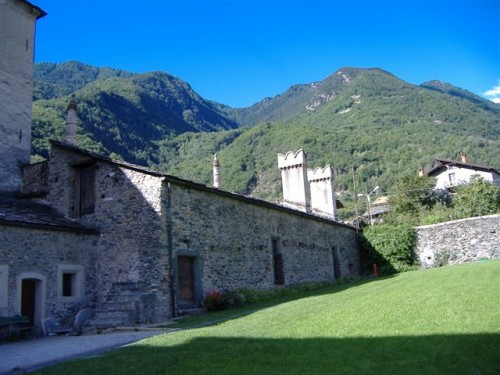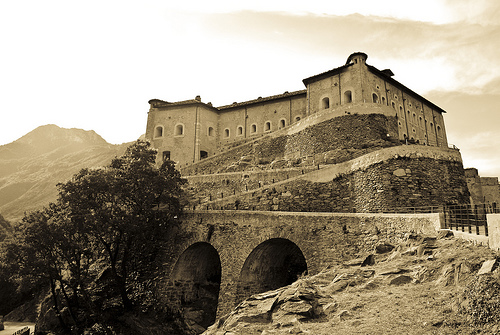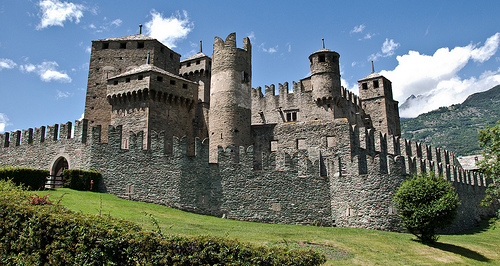When I think of Italy, I usually think of fine wine and food, art history, churches and monuments—but majestic castles typically do not come to mind. Yet throughout Italy, there are so many castles to see! One area that seems to be littered with castles is the Aosta Valley, located on the eastern side of the top of the boot. Each castle tells a story. Some were originally constructed for protection from the neighboring French and Swiss and others were opulent residences. Whatever the reason, we should be thankful to have such great structures still standing. Here are five worth a visit.
Verrés Castle
Verrés Castle has been perched on a cliff overlooking the river Evancon since 1390. It was used as a method of defense during the Middle Ages, equipped with buttresses, embrasures, and turrets for cannons. Inside, there is a grand staircase, stone vaults, and quite a few fireplaces. It was rescued by Piedmont intellectuals who were interested in preserving the castle and all of its medieval history. Because of these people, today we are able to explore this well-conserved structure. The castle also annually serves as the backdrop for the Historic Carnival of Verrés, which includes an entertaining re-enactment of the story of the Countess Caterina of Challant.
Issogne Castle
Issogne Castle has a long history and has been restored a number of times. First in 1400 by Ibleto of Challant; In 1490 and 1510 by a prior of Sant’Orso George of Challant who turned it into a luxurious residence for his cousin, Margaret de la Chambre. In 1872, the artist Vittorio Avondo restored Issogne Castle again and then in 1907 donated it to the state so that everyone could enjoy its majestic beauty. In the front hall, there are frescoes of everyday life; a tailor’s workshop, a delicatessen, a pharmacy, a butcher, guards, and a grocer market. The dining room, the kitchen, the Baron’s Hall, the Chapel, the Countess’s room, the “King of France’s” room, and the “Knights of St. Maurice” room are all open to the public year round.
Forte di Bard
Forte di Bard was a garrison for soldiers during Theodoric’s reign in the 6th century. There are also documents from 1034 referencing the fort—one of the oldest references to a castle in the Aosta Valley. In 1242, it was taken over by the Savoy family. Forte di Bard was integral in thwarting Napoleon Bonaparte’s French artillery advance into Italy. For two weeks, the army could not seize the fort, although the town of Bard was not protected from the French. After this span of time, the fort fell and had to surrender, freeing the French Army to move further past Bard. In 1830 the fort was reconstructed from its Napoleonic encounter, but has only recently (2006) opened to the public as the Museum of the Alps. In the summertime, Forte di Bard also hosts musical and theatrical shows in its courtyard.
Castello Saint-Pierre
Built to stand on a rocky spur, the Castle of Saint-Pierre dates back to the 11th century, but its first recorded reference was much later, in 1191. Its fairy-tale appearance, with its turrets and merlons, is attributed to nineteenth-century construction. Many liken its shape to that of a Disney castle, even though it is one of the oldest castle structures in the Aosta Valley. Today, you can visit the Castle of Saint-Pierre and also the Regional Museum of Natural Science it houses within its walls.
Castello di Fénis
Fénis Castle is famous for its many towers and battle walls. When it was first built around 1242, it was most likely a very simple structure. But from 1320 to 1420, Aimone of Challant and his son Bonifacio expanded the castle to its pentagonal arrangement with the towers and walls. The castle is situated unexpectedly on a knoll instead of a strategic location for defense. This is because it was constructed as a luxury residence for the Challant family. It stayed in the family until around 1716, when it was sold during the period of its decline. This great prestigious castle was then used as a stable and a barn. But in 1895, it was restored, and today is a museum where you can see a fifteenth-century fresco of Saint George killing a dragon, and balcony walls painted with the images of prophets and sages.
Do you have a favorite castle in Italy to share?
Written by Stephanie Photo Credits : roachy737 / paola25 / Daniele Sartori / Wiggytoo / stijn





